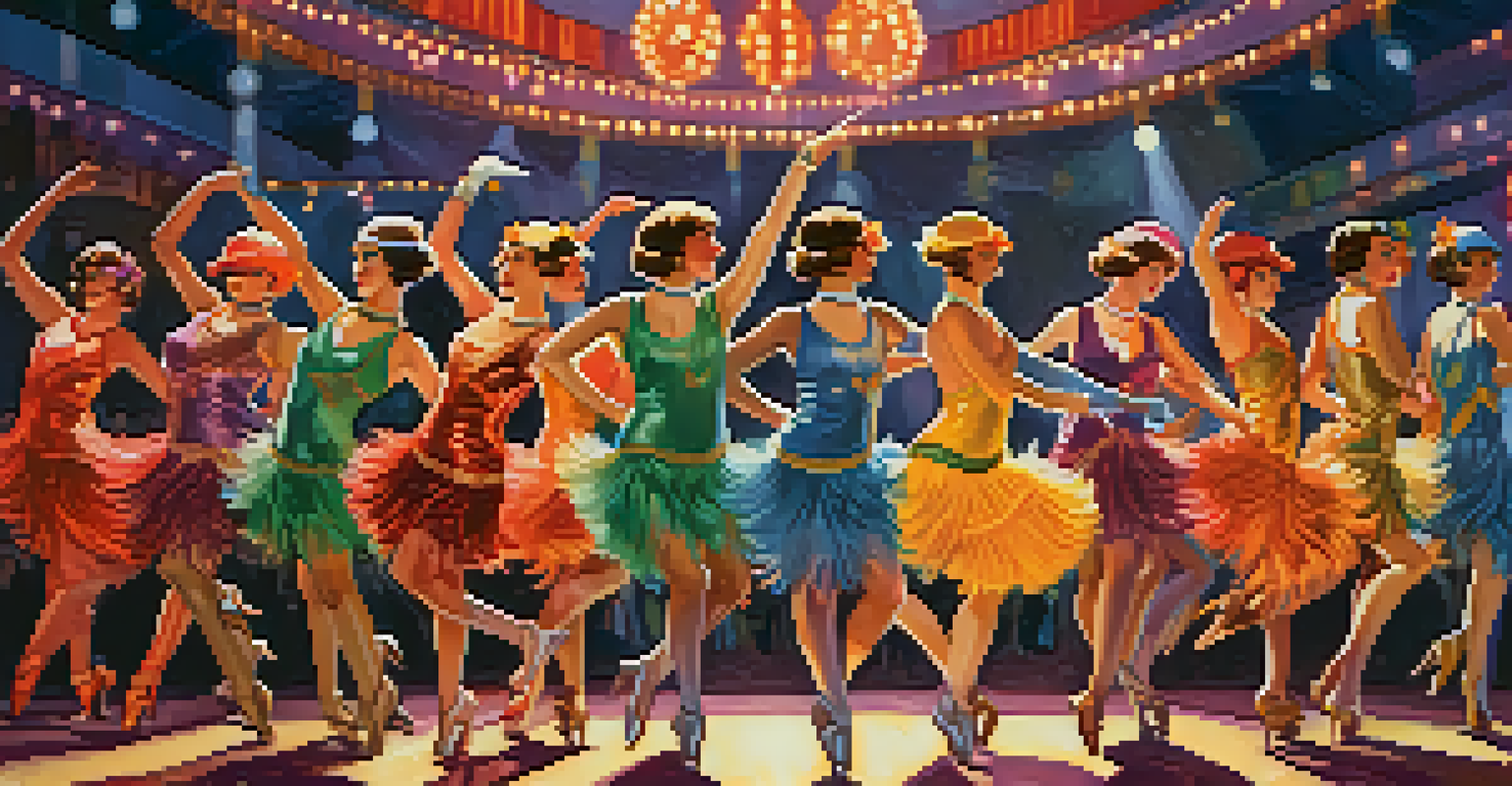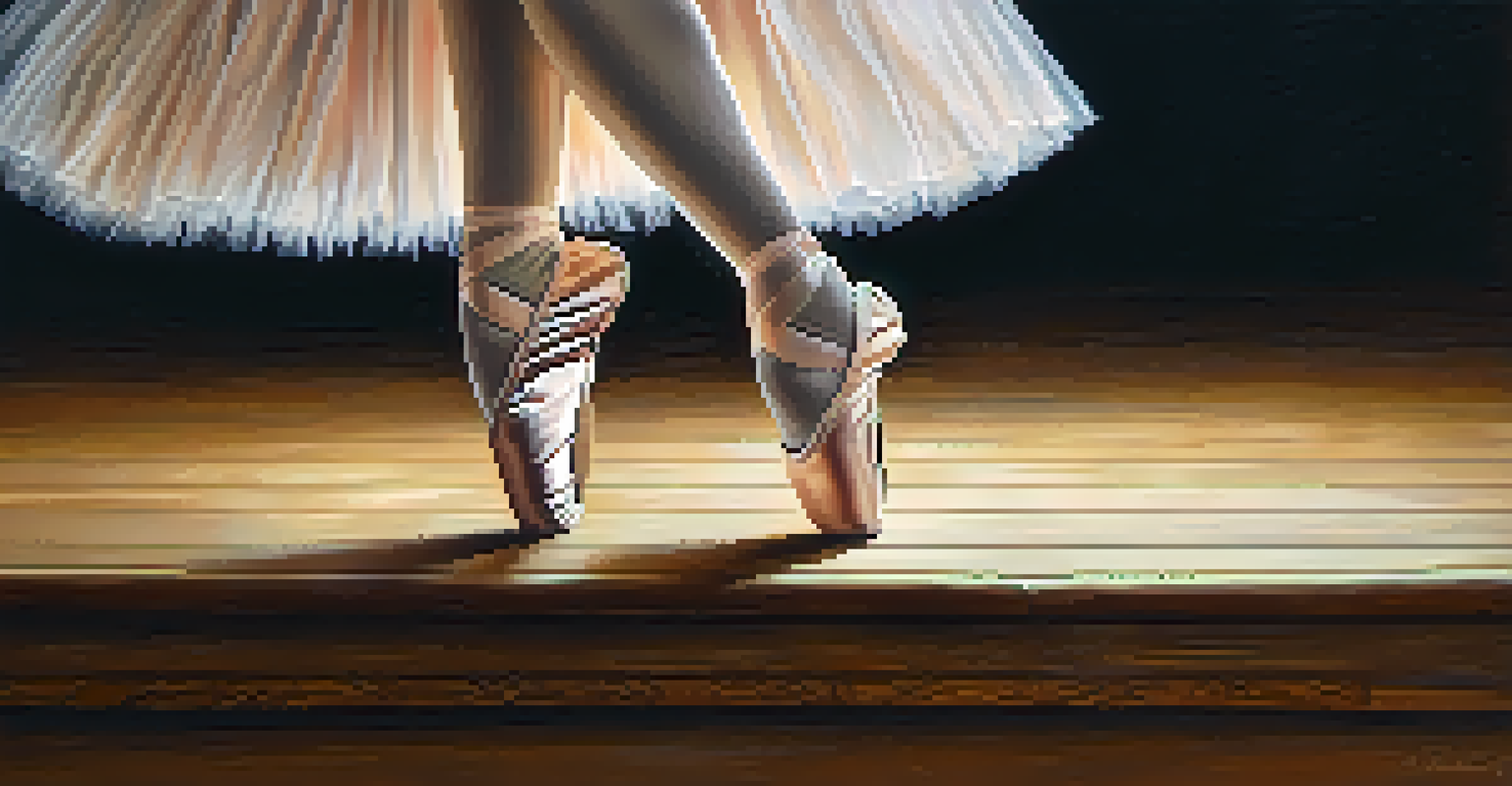Fashion and Dance: Collaborating for Visual Storytelling

The Intersection of Fashion and Dance: A Creative Synergy
Fashion and dance have long been intertwined, each enhancing the other in unique ways. When dancers wear vibrant costumes, it not only complements their movements but also tells a story. This synergy creates a visual feast for the audience, bringing emotions and narratives to life.
Fashion is the armor to survive the reality of everyday life.
Consider a ballet performance where tutus swirl and shimmer under the stage lights; each piece of clothing contributes to the overall aesthetic. The colors, textures, and shapes of the costumes can evoke different feelings, making the experience richer. This collaborative art form shows how both disciplines can elevate each other.
As designers and choreographers work hand in hand, they push the boundaries of creativity. The result is a captivating experience that resonates with viewers on multiple levels, proving that the fusion of fashion and dance is not just an artistic choice but a powerful storytelling tool.
Historical Roots: How Fashion Influenced Dance Styles
Throughout history, fashion has significantly influenced various dance styles. For example, the flapper dresses of the 1920s embodied the spirit of the Jazz Age, encouraging more liberated dance movements. This connection illustrates how societal trends in fashion can inspire shifts in dance culture.

In traditional dance forms, such as Bharatanatyam or Flamenco, costumes play a crucial role in conveying cultural heritage. Each garment tells a story of its own, representing the dance's origins and the emotions it expresses. This historical context enriches the performance, making it more than just a display of skill.
Fashion Enhances Dance Performances
Costumes play a crucial role in amplifying a dancer's movements and conveying the emotional depth of the narrative.
As we examine these historical intersections, we see how fashion not only reflects the era's sensibilities but also shapes the way dance evolves. This ongoing dialogue between the two art forms continues to create new styles and expressions, keeping both relevant and exciting.
Modern Collaborations: Designers and Dancers Unite
In today's world, we see more collaborations between fashion designers and dancers than ever before. Renowned designers often create bespoke costumes for performances, merging high fashion with movement. This trend not only elevates the dancers' appearance but also transforms the stage into a canvas of artistry.
Dance is the hidden language of the soul.
Take, for example, the partnership between fashion houses and contemporary dance companies. By integrating innovative materials and designs, they create visually stunning performances that captivate audiences. Such collaborations allow for experimentation, pushing the boundaries of both disciplines.
Moreover, these partnerships often spill over into the commercial realm, influencing everyday fashion trends. The visibility of dance in fashion shows can inspire individuals to embrace a more expressive style, demonstrating that the connection between these two worlds is both artistic and practical.
The Role of Costumes in Enhancing Performance
Costumes are not merely decorative in dance; they play a vital role in enhancing the overall performance. A well-designed costume can amplify a dancer's movements, making them appear more fluid and graceful. This aspect is crucial, especially in styles like contemporary dance, where the body’s expression is paramount.
Different fabrics and cuts can affect how a dancer moves, influencing their range of motion. For instance, a flowing gown can create dramatic effects during spins and turns, adding a visual element that captivates the audience. Thus, the interplay between movement and costume design is fundamental to achieving a compelling performance.
Social Media Boosts Creative Synergy
Platforms like Instagram and TikTok have transformed the collaboration between fashion and dance, inspiring new trends and accessibility.
Moreover, costumes can serve as a narrative device, helping to convey the story behind the dance. By thoughtfully selecting colors and styles, choreographers and designers can enhance the emotional depth of the performance, allowing the audience to connect more profoundly with the narrative being portrayed.
Visual Storytelling: Creating Emotion Through Movement and Style
Visual storytelling in dance extends beyond movement; it encompasses the attire worn by performers. Each costume choice can evoke specific emotions, guiding the audience's interpretation of the narrative. For instance, vibrant colors might signal joy, while darker shades could suggest sorrow or tension.
Think of a theatrical dance performance where the costumes change with each act, mirroring the emotional journey of the characters. This dynamic visual element keeps the audience engaged, as they are not just passively watching but actively interpreting the evolving story. The fusion of fashion and dance invites viewers to feel alongside the performers.
Ultimately, the collaboration between fashion and dance enriches visual storytelling. By seamlessly integrating costumes with choreography, artists create layered narratives that resonate deeply with the audience, leaving a lasting impression long after the curtain falls.
The Impact of Social Media on Fashion and Dance Collaborations
In the age of social media, the collaboration between fashion and dance has reached new heights. Platforms like Instagram and TikTok allow dancers to showcase their work alongside the latest fashion trends, creating a vibrant community of creative expression. This visibility has transformed how both industries interact and evolve.
Dancers often use social media to highlight their unique styles, inspiring designers to take notice. A viral dance challenge can lead to a surge in demand for specific clothing styles, illustrating the powerful influence of these platforms. This cycle of inspiration encourages collaboration, with designers eager to dress dancers who can showcase their creations.
Innovations Shape Future Collaborations
Emerging technologies and sustainable practices are set to redefine how fashion and dance interact, leading to innovative performances.
Furthermore, social media fosters a sense of accessibility, allowing emerging artists to gain recognition. This democratization of creativity encourages diverse voices, resulting in fresh collaborations that reflect a broader range of experiences and styles. The interplay between fashion and dance continues to thrive in this digital landscape.
Future Trends: Where Fashion and Dance are Headed
As we look to the future, the collaboration between fashion and dance is set to evolve in exciting ways. Innovations in technology, such as wearable tech, could redefine how costumes are designed and utilized in performances. Imagine dancers wearing outfits that change color or shape in response to their movements, creating an interactive experience.
Moreover, sustainability is becoming a crucial consideration in both industries. Designers are increasingly focusing on eco-friendly materials, while dancers advocate for costumes that are not only stunning but also ethically produced. This shift reflects a growing awareness of the environmental impact of fashion and performance.

Ultimately, the future of fashion and dance collaborations promises to be dynamic and transformative. As artists continue to explore new ideas and push boundaries, we can expect to see innovative performances that resonate with audiences and set new trends in visual storytelling.